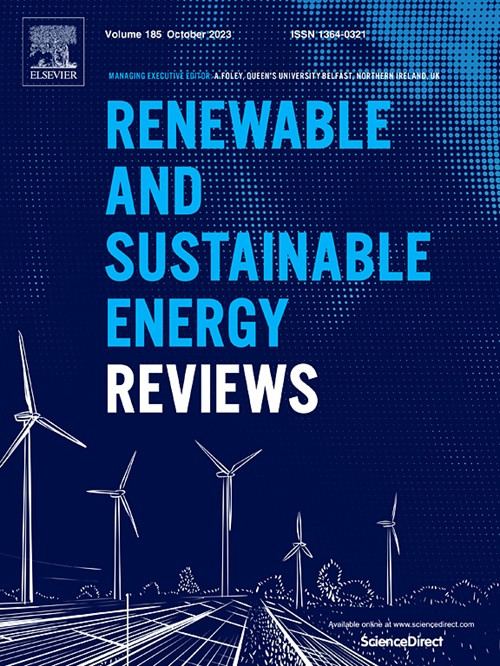环境和能源应用的单原子催化剂的进展和见解
IF 16.3
1区 工程技术
Q1 ENERGY & FUELS
引用次数: 0
摘要
未来的可再生能源供应和可持续的生态系统依赖于许多重要的催化过程。寻找稳定高效的催化剂对促进这些催化过程具有重要意义。单原子催化剂(SACs)集均相催化和多相催化的优点于一体,越来越受到研究人员的关注。单个金属原子可以通过各种不饱和化学位点或空间限制在载体上稳定,以最大限度地提高原子利用效率。然而,它们的高表面能需要仔细限制单原子负载,以防止聚集,这可能会对催化性能产生不利影响,即使单个原子表现出高活性。因此,迫切需要探索SACs的配位结构和催化机理,实现单原子催化剂的调控和优化,激发其在可持续发展中的潜在应用。本文综述了近年来单原子催化剂的几种重要制备方法以及在污染物净化和能量转换领域的研究进展。我们还讨论了催化机制和构效关系,特别是处理表面物质和载体对催化活性的影响,以及由金属/载体相互作用调制的单原子中心的独特结构和电子性质对催化活性和选择性的影响。本综述的数据来源于对Web of Science和Scopus数据库中相关出版物的系统分类和分析。通过对这些文献的深入研究,本文旨在阐明sac在能源和环境领域发展的主要趋势,同时突出其独特的科学价值和重要的应用潜力。DFT计算揭示了单原子中心独特的结构和电子性质如何通过金属/载流子相互作用影响催化活性和选择性,为sac的设计和应用提供了新的理论依据。最后,对单原子催化的未来进行了展望,旨在为SACs在可持续环境发展和可再生能源供应中的未来研究提供见解。本文章由计算机程序翻译,如有差异,请以英文原文为准。
Advancements and insights into single-atom catalysts for environmental and energy applications
Future renewable energy supplies and sustainable ecosystems depend on many important catalytic processes. The search for stable and efficient catalysts is important for the promotion of these catalytic processes. Single-atom catalysts (SACs), which integrate the benefits of both homogeneous and heterogeneous catalysis, are increasingly attracting the attention of researchers. The individual metal atoms can be stabilized on the carrier by various unsaturated chemical sites or spatial confinement to maximize the efficiency of atom utilization. However, their high surface energy necessitates careful limitation of single-atom loading to prevent aggregation, which can adversely affect catalytic performance, even though individual atoms exhibit high activity. Therefore, there is an urgent need to explore the coordination structure of SACs as well as the catalytic mechanism to achieve the regulation and optimization of single-atom catalysts and to stimulate their potential application in sustainable development. In this paper, we review several important preparation approaches of single-atom catalysts and the research progress in the fields of contaminant purification and energy conversion in recent years. We also discuss the catalytic mechanisms and structure-activity relationships, specifically addressing the influence of surface species and supports on catalytic activity, as well as the effects of the unique structural and electronic properties of single-atom centers, modulated by metal/support interactions, on catalytic activity and selectivity. This review draws on data derived from a systematic sorting and analysis of relevant publications in the Web of Science and Scopus databases. Through an in-depth examination of these literatures, this paper aims to elucidate the key trends in the development of SACs in the fields of energy and environment, while highlighting their unique scientific value and significant application potential for readers. DFT calculations have revealed how the unique structure and electronic properties of single-atom centers affect catalytic activity and selectivity through metal/carrier interactions, providing a new theoretical basis for the design and application of SACs. Finally, the future of single-atom catalysis is envisioned, aiming to provide insights for future studies of SACs in sustainable environmental development and renewable energy supply.
求助全文
通过发布文献求助,成功后即可免费获取论文全文。
去求助
来源期刊

Renewable and Sustainable Energy Reviews
工程技术-能源与燃料
CiteScore
31.20
自引率
5.70%
发文量
1055
审稿时长
62 days
期刊介绍:
The mission of Renewable and Sustainable Energy Reviews is to disseminate the most compelling and pertinent critical insights in renewable and sustainable energy, fostering collaboration among the research community, private sector, and policy and decision makers. The journal aims to exchange challenges, solutions, innovative concepts, and technologies, contributing to sustainable development, the transition to a low-carbon future, and the attainment of emissions targets outlined by the United Nations Framework Convention on Climate Change.
Renewable and Sustainable Energy Reviews publishes a diverse range of content, including review papers, original research, case studies, and analyses of new technologies, all featuring a substantial review component such as critique, comparison, or analysis. Introducing a distinctive paper type, Expert Insights, the journal presents commissioned mini-reviews authored by field leaders, addressing topics of significant interest. Case studies undergo consideration only if they showcase the work's applicability to other regions or contribute valuable insights to the broader field of renewable and sustainable energy. Notably, a bibliographic or literature review lacking critical analysis is deemed unsuitable for publication.
 求助内容:
求助内容: 应助结果提醒方式:
应助结果提醒方式:


